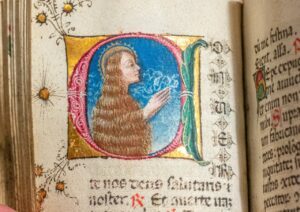
We are pleased to announce the recent arrival of a number of Books of Hours, exquisite manuscripts that served as both devotional tools and extraordinary works of art in the Middle Ages and Renaissance. These books intricately reflect the canonical hours of the day, a structured schedule of prayers and readings that punctuated monastic life and spiritual observance.
The canonical hours consist of eight key periods: Matins, Lauds, Prime, Terce, Sext, None, Vespers, and Compline. Each hour is devoted to specific prayers, psalms, and readings, marking time in a way that invites the faithful to immerse themselves in spiritual reflection and connection with God throughout the day.
Matins is traditionally observed during the night or the early morning, focusing on prayer and contemplation. It often includes the recitation of psalms and readings that set the tone for the day ahead. Lauds follows at dawn, celebrating the new day with hymns of praise. The hours of Prime, Terce, Sext, and None divide the morning and early afternoon into moments of prayer, each hour corresponding to the time of day, and encouraging individuals to take a pause in their daily activities for spiritual refreshment.
Vespers, held in the evening, is a particularly significant hour, often marked by the singing of canticles and the lighting of candles, symbolising the illumination of Christ in the darkness of the world. Finally, Compline is said at the day’s end, providing a moment of reflection and thanksgiving for the day’s blessings, along with prayers for protection during the night.
Books of Hours adapted the Liturgy of the Hours for laypeople, allowing them to embrace these spiritual practices at home. They often contain a rich tapestry of texts that include the Hours of the Virgin, suffrages, and various prayers, offering flexibility for personal devotion. Notably, they often feature a calendar of feast days, allowing users to observe the church year in tandem with their daily prayers.
The artistic elements of these manuscripts are equally impressive, as many are richly illuminated and filled with stunning artwork that enhances the spiritual experience. Initials and borders adorned with gold leaf, intricate flourishes, and vibrant colours not only beautify the text but also serve as visual meditations on the spiritual themes contained within. These artistic embellishments were created by skilled illuminators who sought to inspire reverence and devotion, making each Book of Hours a unique blend of religious utility and artistic expression.
Historically, the popularity of Books of Hours surged in the late Middle Ages, particularly in the 14th and 15th centuries. They became cherished possessions across Europe, often personalised with individual prayers and inscriptions, reinforcing the intimate connection between the user and their faith. Due to their personal nature, these manuscripts often reflect the owner’s identity, aspirations, and community, making each volume a treasure trove of history.
Today, these remarkable volumes continue to captivate and inspire readers and collectors alike, reminding us of the timeless pursuit of faith and reflection. The reverberations of the canon’s structured rhythm resonate today, offering contemporary worshippers a framework for understanding the sacredness of time, devotion, and the cyclical nature of prayer.
Please look out for the Books of Hours which we will be describing, photographing and videoing for our website and on Instagram. For further details or information email us info@butlerrarebooks.co.uk